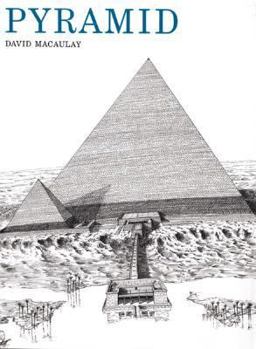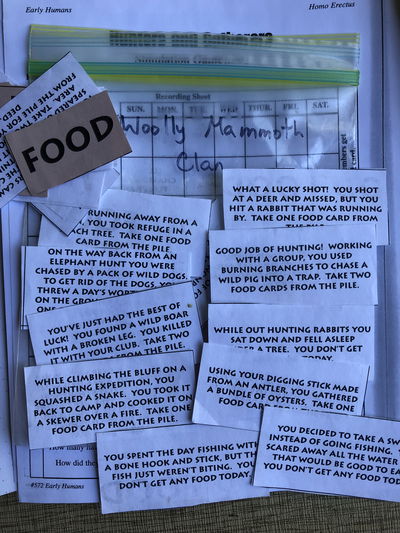Here's my list of favorite Picture Books for Simple Machines!
I really like to do lists on the blog because if someone else knows of something that could go on the list, they can share! So I'm hoping we can do some group brainstorming of examples of animals using tools.
Note: Ruzuku courses also have this collaborative aspect and once I finish teaching this block, I'll publish the course. I always like to wait until I've taught something several times before I put my notes in course format.
So, why tools? I'm starting this time with the Inclined Plane, which got me thinking about Ancient Egypt, which got me thinking about the Copper Age and Bronze Age.

Pyramid
by David Macaulay
In Ancient Egypt, the Bronze Age begins in 3150 BCE.
This book takes place in 2470 BCE.
Thinking about the Copper Age and Bronze Age got me thinking about Early Humans, which led me to chapter 2 & 3 of A Child's History of the World (1951 edition) by V.M. Hillyer. This was, by the way, my absolute favorite book as a child!

A Child's History of the World
chapter 2: Umfa-Umfa and Itchy-Scratchy
chapter 3: Fire! Fire!! Fire!!!
The list of six simple machines is Inclined Plane, Screw, Wedge, Lever, Pulley, and Wheel & Axle.
We began by reading the two chapters from Hillyer. "Umfa-Umfa and Itchy Scratchy" is the Stone Age, and "Fire! Fire!! Fire!!!" explains the discovery of copper and tin ore, and how tools became gradually more sophisticated.
Fun Fact:
Copper was first used by man over 10,000 years ago. A copper pendant discovered in what is now northern Iraq has been dated about 8700 BCE.
Then our conversations will transition from early toolmaking to simple machines, and I think it would be fabulous to look at how some ancient structures were built. Which machines did they use to make the work easier?
3000 BCE
Of course Hiller's is an old book, and so when I was reading it aloud several places caught my notice. On page 13 he writes,
- "But Primitive Men had two things that helped them more than sharp claws, or strong muscles, or tough skins. They had better brains than any animals. And they had hands instead of front feet. With their brains they could think. They could think of ways of doing things better.
With their brains they could think of using tools. With their hands they could make tools and use them. Animals don't use tools. Men do. Instead of sharp teeth, men could use spears. In place of a furry skin to keep them warm, men could use the skins of animals."
"They had hands instead of front feet" is nice phrasing. A few ideas popped into my head when I read this. One was to do the "Great Thumbless Survival Test" on page 30 of Blood and Guts: A Working Guide to Your Own Insides by Linda Allison.

Great Thumbless Survival Test, p.30
Another was to use two "mug plugs" to
make the saddle joint model from "Make Your Own Joints" on pages 56 and 27 (a "mug plug" is perfect for carving the saddle joint at the base of the thumb) of The Human Body: 25 Fantastic Projects Illuminate How the Body Works by Kathleen Reilly.


Make Your Own Joints, pp.56-57
I had already been planning on talking about stone tools when we got to the Wedge (two inclined planes put together) and I am hopeful that my new Paleolithic Stone Took Kit from Clocca Concepts will arrive in time! I'm also a huge fan of the "Hunters and Gatherers Simulation Game" from Early Humans by Michelle Breyer, so that goes perfectly with stone tools as well.

Hunters and Gatherers Simluation Game, pp.133-140

I also think we will use the "Flint Knapping" and "Stone Tools" information on pages 124-125.
However, I also noticed while reading aloud this section on page 13 of Hillyer that it is no longer considered true that "Animals don't use tools. Men do." So I will need to revise that portion when I share this book with children in the future.
Every once in a while, I run across an article about some animal that has been discovered using tools. I'd like to start a collection of those articles here. Please let me know if you find a good one!
A tool-wielding octopus? This invertebrate builds armor from coconut halves
Scientific American - Dec 14, 2009
Myth Busting: The Truth About Animals and Tools
NPR - Dec 23, 2011
Primate tool-use: Chimpanzees make drinking sticks
BCC - Jan 10, 2017
Asian elephants are capable of using water as a tool
phys.org - Aug 4, 2020
this one is interesting because one elephant solved the task right away but no other elephant could figure it out... even after watching her demonstrate
They Were the Last of Their Kind, in Captivity. Can 5 Survive the Wild?
The New York Times - Dec 4, 2024
Of course, this may lead us into some interesting conversations about the differences between animals and humans. When exactly did we become something different from them? What is it that makes us human?
It's fun to change up the order of something to see if it helps students gain a better understanding.
The 6th grade Physics block is typically called "Sound, Light, Heat" but last time I put Heat first and it worked much better! The 7th grade Creative Writing block is typically called "Wish, Wonder & Surprise" but Dorit Winter argues in her book The Art and Science of Teaching Composition that it should be Wonder, Wish & Surprise.
I ran across a PPT on Simple Machines from the Thomas Jefferson National Accelerator Facility and it started with Inclined Planes and Ancient Egypt. And I thought, why not? And then the ideas started flowing from there.
This post contains affiliate links to materials I truly use for homeschooling. Qualifying purchases provide me with revenue. Thank you for your support!




 Immersive Experience
Immersive Experience Immersive Experience
Immersive Experience







No comments:
Post a Comment